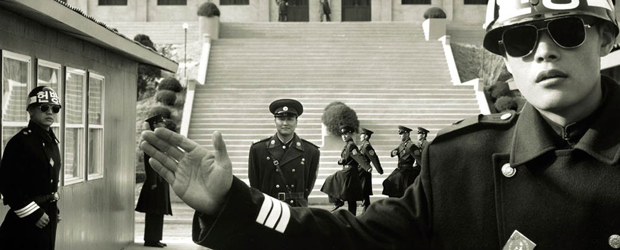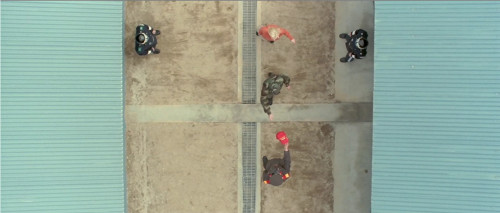Movie Review – J.S.A.: Joint Security Area
· Joint Security Area Review

A bit of history to explain the hostility between North and South Korea – At the end of World War two, after the surrender of Japanese forces, Korea was divided into two states, with the North under Soviet occupation and the South under U.S. occupation. The communist government in North Korea received backing from Soviet Union and the democracy in South was backed by USA which eventually led to Korean War in 1950. Korean War ended in a stalemate in 1953 without any side winning. As part of the Cease-fire Agreement, a 4km-wide Demilitarized Zone (DMZ) was created to act as a buffer between the North and South. A Joint Security Area was also created in Panmunjom, where discussions between the two sides can take place. The major incidents of the movie take place at this place.
In the face of it, the movie is a mainstream thriller. A crime happens, some people die and an investigation is called. The movie starts with a Swiss military officer of Korean ancestry - Major Sophie Jean arriving in Panmunjom to conduct the investigation called on by both the Koreas. Due to the mutual distrust between the two nations, the investigation is to be conducted by a neutral third party - Neutral Nations Supervisory Commission (NNSC). The depositions have already been filed by the soldiers involved from both sides and she soon starts finding inconsistencies in them. Despite the political themes being at the center of the film, it quickly moves away from them to tell a different story. Major Sophie Jean’s story is soon sidelined by a separate narrative, the story of a doomed friendship between two North Korean and two South Korean soldiers. The director does not try to build suspense and the timeline of the movie continuously shifts between past and present showing the actual version of the events that happened and the investigation being carried on.
The actual version of events that happened show a tragic end to a doomed friendship between two South Korean and two North Korean soldiers. A random scene, which shows Sgt. Oh handing over the cap of an American tourist which has flown over to the North side on the North-South border tries to establish his character. A high angle shot is used which very clearly and geometrically shows the border separating the two nations. Another tourist tries to take a photograph of Sgt. Oh, even though photography is prohibited. One night during an expedition a group of South Korean soldiers stray into North Korea’s land and hastily leave when they realize their mistake. The protagonist of the movie, Sgt. Lee gets left behind. To make it worse, he realizes that he is trapped in a land-mine. He struggles unsuccessfully to dismantle it. Right then, two North Korean soldiers, including Sgt. Oh, come by. In a comical scene where both the parties are unsure what to do as it is an unprecedented situation for them, there is a struggle which ends in a stalemate as Sgt. Lee is standing on a mine and can trip it to kill all of them. As the other two start to leave him in his miserable condition, he starts crying. Taking pity on him, Sgt. Oh helps him dismantle the mine and sets him free. The initial mistrust and animosity between these enemy soldiers is dissolved by this act of kindness to pave way for a possible friendship.
Sgt. Lee keeps on seeing the two North Korean soldiers at different times during his duties. Then one night when Sgt. Lee and his friend, Pvt. Nam are on guard duty, Sgt. Lee decides to send a letter to the two soldiers on the other side. He gets a favorable response from the other side and starts communicating with them on a regular basis. Another fateful night, when his companion is asleep, he takes the initiative and crosses the border to visit the guard post on the other side! After the two North Korean soldiers recover from the initial shock, they welcome him and after this initial meeting, the three of them start meeting regularly. Then one night, Sgt. Lee brings along Pvt. Nam along with him to meet his new friends. The next few months show a flourishing friendship between the four of them. We see them drinking together, playing games like little kids, sharing little things about their life with one another. Until it all ends.
The moment for which we all had been waiting for arrives when a North Korean officer visits the guard post while all four of them are there. The melancholy music playing in the background suddenly stops when not knowing what to make of the situation, he pulls out his gun an points it on the two South Korean soldiers. Sgt. Lee tries to mediate and bring the situation under control. The bonds of friendship are tested when no one knows how to react to the situation and life of everyone is under threat. That deep initial mistrust between the people of the two nationalities resurfaces. In a moment of clarity, Sgt. Lee realizes the mistake he had made in considering that such a friendship was possible. The melancholy music resumes as the action unfolds. I will not spoil the complete movie by telling all the details. Lots of things happen after that.



Overall, I will give it 8 / 10. The visual style that Park Chan Wook is famous for can be seen in its nascent form in this movie. It may not be Park Chan Wook’s best works, but is still a good watch.
